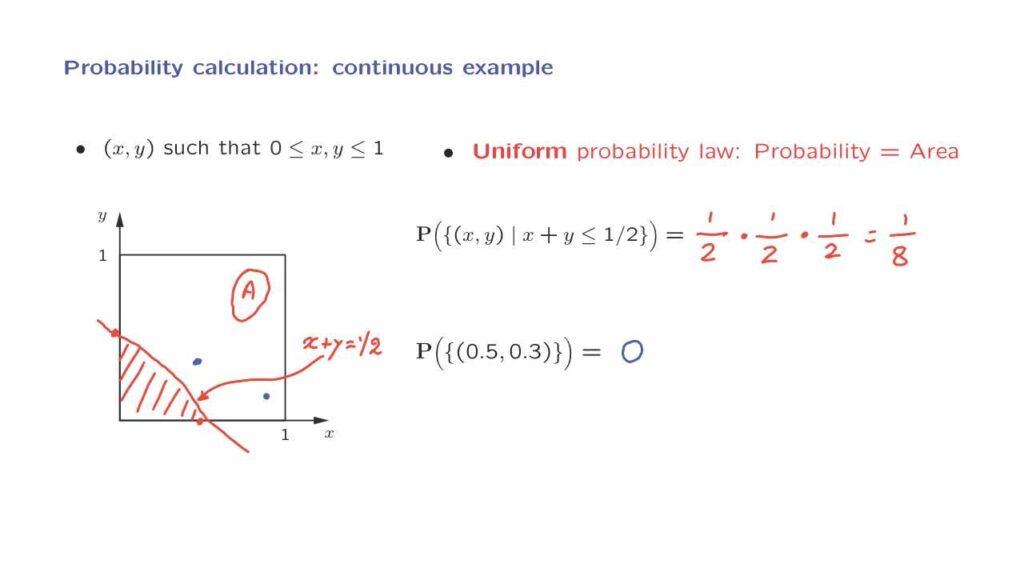We will now go through a probability calculation for the case where we have a continuous sample space. We revisit our earlier example in which we were throwing a dart into a square target, the square target being the unit square.

And we were guaranteed that our dart would fall somewhere inside this set. So our sample space is the unit square itself. We have a description of the sample space, but we do not yet have a probability law.
We need to specify one. The choice of a probability law could be arbitrary. It’s up to us to choose how to model a certain situation. And to keep things simple, we’re going to assume that our probability law is a uniform one, which means that the probability of any particular subset of the sample space is going to be the area of that subset.
So if we have some subset lying somewhere here and we ask what is the probability that we fall into that subset? The probability is exactly the area of that particular subset. Once more, this is an arbitrary choice of a probability law.
There’s nothing in our assumptions so far that would force us to make this particular choice. And we just use it for the purposes of this example. So now let us calculate some probabilities. Let us look at this event. This is the event that the sum of the two numbers that we get in our experiment is less than or equal to 1/2.
It is always useful to work in terms of a picture and to depict that event in a picture of the sample space. So in terms of that sample space, the points that make this event to be true are just a triangle that lies below the line, where this is the line, that’s x plus y equals 1/2. Anything below that line, these are the outcomes that make this event happen.
So we’re trying to find the probability of this red event. We have assumed that probability is equal to area. Therefore, the probability we’re trying to calculate is the area of a triangle.
And the area of a triangle is 1/2 times the base of the triangle, which is 1/2 in our case, times the height of the triangle, which is again 1/2 in our case. And the end result is 1/8.
Let us now calculate another probability. Now, this is an event that consists of only a single element. We take the point 0.5, 0.3, which sits somewhere here. The event of interest is a set, but that set consists of a single point.
So we’re asking for the probability that our dart falls exactly on top of that point. What is it? Well, it is the area of a set that consists of a single point.
What is the area of a single point? It is 0. And similarly for any other single point inside that sample space that we might have considered, the answer is going to be 0.

Let us now abstract from this example, as well as the previous one, and note the following. Probability calculations involve a sequence of four steps. Starting with a word description of a problem, of a probabilistic experiment, we first write down the sample space.
Then we specify a probability law. Let me emphasize again here that this step has some arbitrariness in it. You can choose any probability law you like, although for your results to be useful it would be good if your probability law captures the real-world phenomenon you’re trying to model.
Typically you’re interested in calculating the probability of some event. That event may be described in some loose manner, so you need to describe it mathematically. And if possible, it’s always good to describe it in terms of a picture. Pictures are immensely useful when going through this process.
And finally, the last step is to go ahead and calculate the probability of the event of interest. Now, a probability law in principle specifies the probability of every event, and there’s nothing else to do.
But quite often the probability law will be given in some implicit manner, for example, by specifying the probabilities of only some of the events. In that case, you may have to do some additional work to find the probability of the particular event that you care about.
This last step sometimes will be easy. Sometimes it may be complicated. But in either case, by following this four-step procedure and by being systematic you will always be able to come up with a single correct answer.